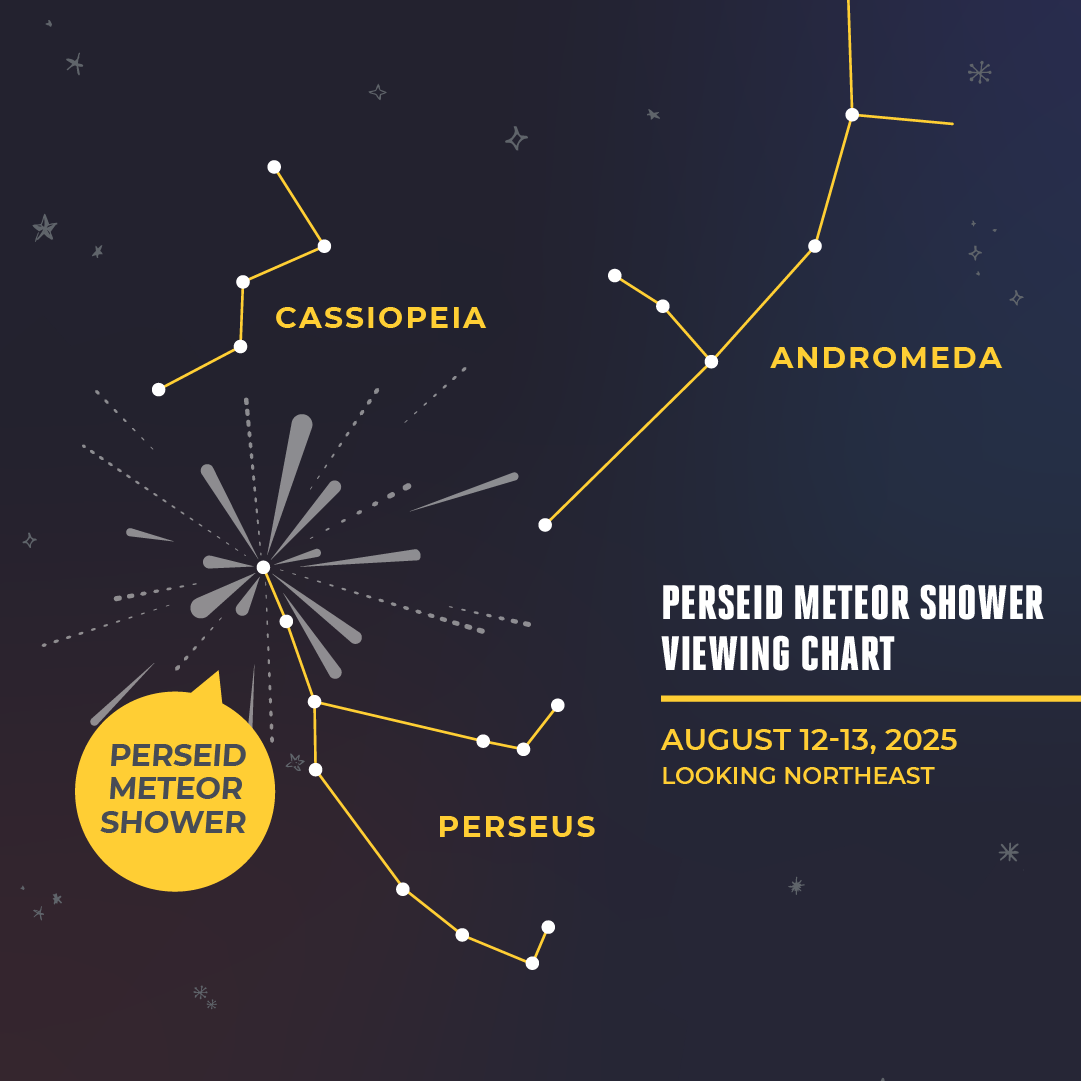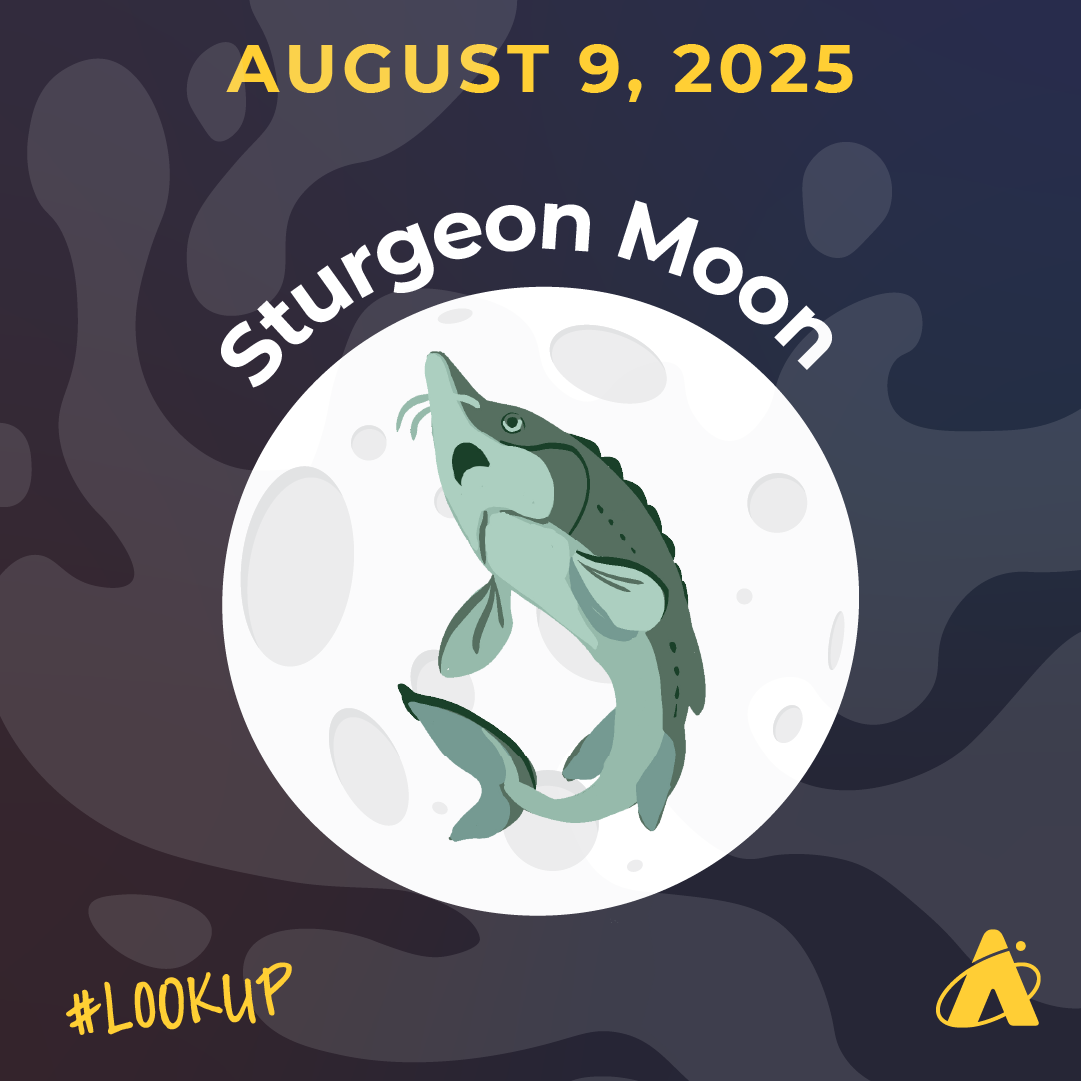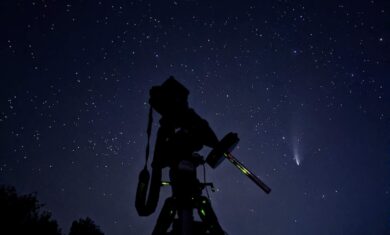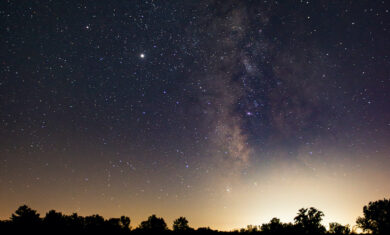Adler Skywatch: August 2025

Header Image: A long-exposure image of shooting stars from the Perseids meteor shower leaving long white streaks across the dark sky, with the Milky Way galaxy visible between them.
A major annual meteor shower peaks, and the sky’s two brightest planets have a close encounter this month. Here’s what you can see in the sky in August, 2025!
The Perseids Meteor Shower
The Perseids—the most reliable summertime meteor shower—peak this month! Named for the constellation Perseus, the Hero, the meteors in this shower all trace back to its radiant point in Perseus.
Like many other annual meteor showers, the Perseids are caused by debris left in space by a comet and can appear anywhere in the sky. There are a few other annual showers that may display as many, or more, meteors than the Perseids, but those take place in wintertime.
How To See The Perseids Meteor Shower

Technically the Perseids meteor shower became active in mid-July; but this year, its predicted peak starts the evening of August 12 through the early-morning darkness of August 13.
Unfortunately, the waning-gibbous Moon rises that night shortly before 10:00 pm, so its glare will block fainter Perseid meteors from view. At the shower’s peak, around 50–75 Perseid meteors per hour are expected under very dark, very clear skies—which will be hard to achieve when the Moon is up. Under moonlit and light-polluted skies, expect to see far fewer than that, maybe only a dozen or so. Face east, look up, and settle in for at least 15–20 minutes to give your eyes a chance to adjust to the darkness. Watch for sporadic quick streaks of light—those are meteors!
Tips For Seeing The Perseids In 2025
The shower is active through late in the month, so one viewing suggestion for seeing more is to look for meteors a day or two (or three!) after the peak, when the Moon rises later. If you go out to look before the Moon rises, you have a better chance of seeing more, and fainter, meteors. There will be fewer meteors, overall, past the peak date, but the few hours of darker skies might help you see some.
Another technique to spot the Perseids is to put the Moon at your back—or behind a tree or building—to help minimize its bright glare.
Planet-Spotting In August, 2025
Venus and Jupiter are shining bright with a few close conjunctions throughout the month. Saturn will be easily spotted in the early-evening, with Mars and Mercury hiding not too far from the Sun setting and rising Sun.
Venus And Jupiter Conjunctions
The brilliant planet Venus (at almost minus-4 magnitude) and the slightly less-bright planet Jupiter (at almost minus-2 magnitude) appear near each other during morning twilight this month. They start the month roughly ten degrees away from each other, low in the east-northeast skies.
You’ll spot Venus first, since it’s practically impossible to miss in a clear dark sky. Venus rises at about 3:00 am for most of the month. Jupiter starts the month rising around 3:30 am, but rises a little earlier each morning.
From August 1 through August 11, Venus appears above Jupiter in the sky; but by August 12, Jupiter appears slightly above Venus. This morning, the two planets appear in a close conjunction—less than one degree apart! After August 12, Jupiter moves roughly a degree higher than Venus each morning, so that by month’s end, the two planets are nearly 20 degrees apart.
The morning of August 20, a very slender waning crescent Moon appears between Venus and Pollux, the brightest star in the constellation Gemini.
Where Is Mercury This Month?
At around zero magnitude this month, Mercury is not as eye-catching as either Venus or Jupiter, but it still is quite bright.
The morning of August 15, Mercury appears far enough above the rising Sun to be visible. Look for it about 40 minutes before sunrise, less than ten degrees above the east-northeast horizon.
On August 20, Mercury starts to sink closer to the horizon each day. The morning of August 21, you may be able to make out a sliver of a waning crescent Moon—only two days before a new Moon—just above Mercury. After August 22, Mercury appears barely 14 degrees away from the Sun’s edge and thus will be difficult, if not impossible, to see.
How To See Saturn And Mars
Saturn will be readily visible in the evening sky this August. It rises in the east around 10:30 pm at the start of the month, and around 8:30 pm by month’s end. It’s slightly brighter than first-magnitude all month long, and is in the sky most of the night. Saturn reaches roughly 40 degrees high in the south at its highest, between 2:30 am–4:00 am and fades in the southwest as dawn brightens the sky.
This month, the planet Mars is dimmer than 1.5 magnitude. It sets not quite two hours after the Sun, and is very low in the west-southwest once the Sun does set; so it may be hard to see. Late in the month, Mars very slowly begins to brighten again, but it spends the next several months too close to the Sun for ready visibility.
Moon Phases In August, 2025

First Quarter Moon: August 1
Full Moon: August 9
Last Quarter Moon: August 16
New Moon: August 23
First Quarter Moon: August 31
Please note: these descriptions are for the Chicago area, using Central time.
Subscribe To Skywatch Wednesday This August
Tour the sky with the Adler Planetarium’s Theaters Manager, Nick, in Skywatch Wednesday. Nick uses cutting edge visualizations, NASA images, and astrophotography to show you what you can see in the night sky throughout the year.
Check out Nick’s latest episode, learn how to see the summer triangle and the constellations that make it up. Plus, see zodiac constellations, Scorpius and Sagittarius, along with several Moon and planet conjunctions, the Perseid meteor shower, and even the Milky Way this summer!
Learn From Our Astronomy Educators
Watch recaps of Sky Observers Hangout livestreams this August! Learn how to observe upcoming cosmic happenings, enhance your astrophotography skills, and see celestial objects through a telescope virtually with our astronomy educators.
In the latest episode, Michelle and Hunter tell you everything you need to know about solar maximum—a period of heightened solar activity that we are currently in! Get a live view of the Sun through our telescopes and learn all about how the Sun’s activity and dynamic weather affects us here on Earth.







